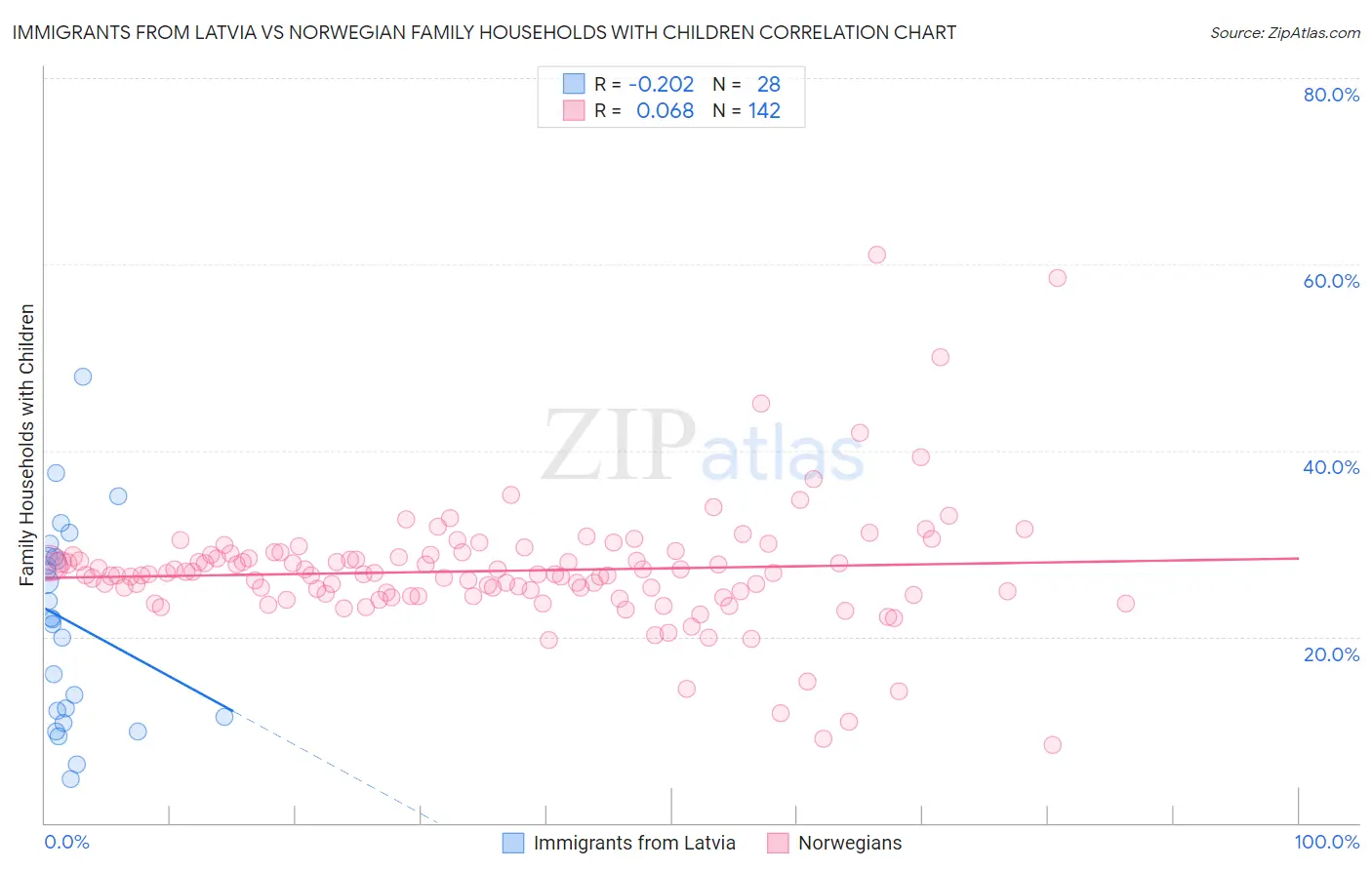Immigrants from Latvia vs Norwegian Family Households with Children
COMPARE
Immigrants from Latvia
Norwegian
Family Households with Children
Family Households with Children Comparison
Immigrants from Latvia
Norwegians
25.9%
FAMILY HOUSEHOLDS WITH CHILDREN
0.0/ 100
METRIC RATING
330th/ 347
METRIC RANK
27.4%
FAMILY HOUSEHOLDS WITH CHILDREN
35.0/ 100
METRIC RATING
197th/ 347
METRIC RANK
Immigrants from Latvia vs Norwegian Family Households with Children Correlation Chart
The statistical analysis conducted on geographies consisting of 113,723,252 people shows a weak negative correlation between the proportion of Immigrants from Latvia and percentage of family households with children in the United States with a correlation coefficient (R) of -0.202 and weighted average of 25.9%. Similarly, the statistical analysis conducted on geographies consisting of 532,567,428 people shows a slight positive correlation between the proportion of Norwegians and percentage of family households with children in the United States with a correlation coefficient (R) of 0.068 and weighted average of 27.4%, a difference of 5.8%.

Family Households with Children Correlation Summary
| Measurement | Immigrants from Latvia | Norwegian |
| Minimum | 4.7% | 8.3% |
| Maximum | 48.0% | 61.1% |
| Range | 43.3% | 52.7% |
| Mean | 21.6% | 27.1% |
| Median | 21.9% | 26.7% |
| Interquartile 25% (IQ1) | 11.7% | 24.5% |
| Interquartile 75% (IQ3) | 28.6% | 28.8% |
| Interquartile Range (IQR) | 16.9% | 4.2% |
| Standard Deviation (Sample) | 10.7% | 6.7% |
| Standard Deviation (Population) | 10.5% | 6.7% |
Similar Demographics by Family Households with Children
Demographics Similar to Immigrants from Latvia by Family Households with Children
In terms of family households with children, the demographic groups most similar to Immigrants from Latvia are Slovene (25.8%, a difference of 0.13%), Cypriot (25.9%, a difference of 0.18%), Immigrants from Albania (25.9%, a difference of 0.31%), Immigrants from Austria (25.8%, a difference of 0.36%), and Immigrants from Barbados (26.0%, a difference of 0.41%).
| Demographics | Rating | Rank | Family Households with Children |
| Immigrants | Australia | 0.0 /100 | #323 | Tragic 26.0% |
| Chinese | 0.0 /100 | #324 | Tragic 26.0% |
| Barbadians | 0.0 /100 | #325 | Tragic 26.0% |
| Immigrants | Ireland | 0.0 /100 | #326 | Tragic 26.0% |
| Immigrants | Barbados | 0.0 /100 | #327 | Tragic 26.0% |
| Immigrants | Albania | 0.0 /100 | #328 | Tragic 25.9% |
| Cypriots | 0.0 /100 | #329 | Tragic 25.9% |
| Immigrants | Latvia | 0.0 /100 | #330 | Tragic 25.9% |
| Slovenes | 0.0 /100 | #331 | Tragic 25.8% |
| Immigrants | Austria | 0.0 /100 | #332 | Tragic 25.8% |
| Immigrants | Switzerland | 0.0 /100 | #333 | Tragic 25.7% |
| Slovaks | 0.0 /100 | #334 | Tragic 25.7% |
| Immigrants | Croatia | 0.0 /100 | #335 | Tragic 25.7% |
| Immigrants | West Indies | 0.0 /100 | #336 | Tragic 25.7% |
| Puerto Ricans | 0.0 /100 | #337 | Tragic 25.6% |
Demographics Similar to Norwegians by Family Households with Children
In terms of family households with children, the demographic groups most similar to Norwegians are Cheyenne (27.4%, a difference of 0.0%), Immigrants from Romania (27.4%, a difference of 0.010%), Crow (27.4%, a difference of 0.020%), Immigrants from Iran (27.4%, a difference of 0.030%), and Swedish (27.4%, a difference of 0.050%).
| Demographics | Rating | Rank | Family Households with Children |
| Immigrants | Uruguay | 37.7 /100 | #190 | Fair 27.4% |
| Sudanese | 37.6 /100 | #191 | Fair 27.4% |
| Pennsylvania Germans | 37.5 /100 | #192 | Fair 27.4% |
| Swedes | 36.9 /100 | #193 | Fair 27.4% |
| Immigrants | Iran | 36.1 /100 | #194 | Fair 27.4% |
| Crow | 35.7 /100 | #195 | Fair 27.4% |
| Cheyenne | 35.1 /100 | #196 | Fair 27.4% |
| Norwegians | 35.0 /100 | #197 | Fair 27.4% |
| Immigrants | Romania | 34.4 /100 | #198 | Fair 27.4% |
| English | 32.0 /100 | #199 | Fair 27.3% |
| Immigrants | Congo | 28.7 /100 | #200 | Fair 27.3% |
| Bhutanese | 25.1 /100 | #201 | Fair 27.3% |
| Americans | 22.8 /100 | #202 | Fair 27.3% |
| Kiowa | 22.2 /100 | #203 | Fair 27.3% |
| Immigrants | Sudan | 21.6 /100 | #204 | Fair 27.3% |